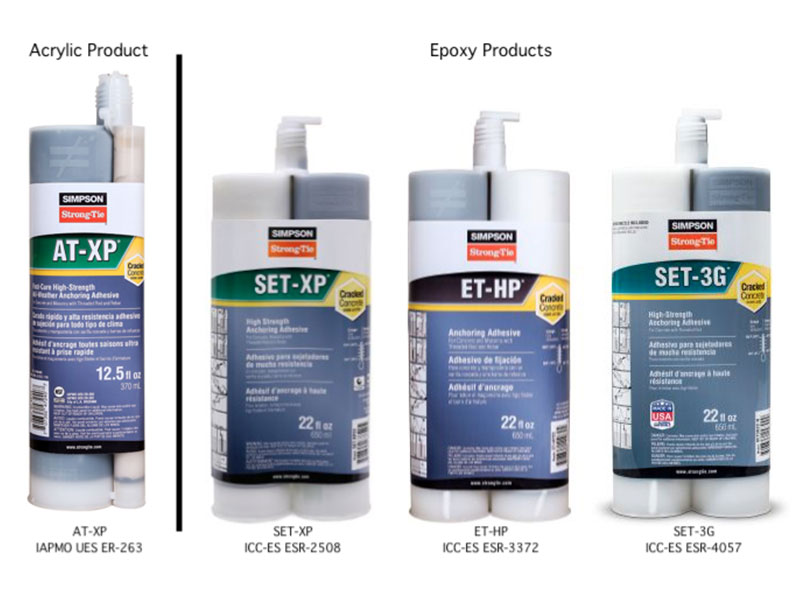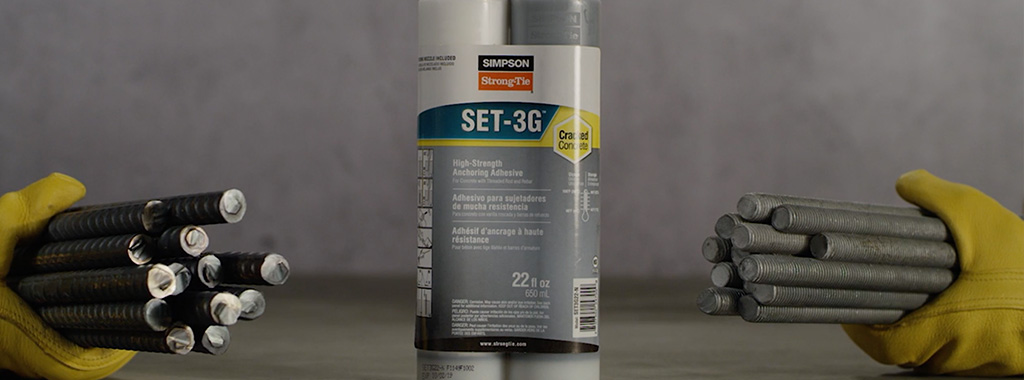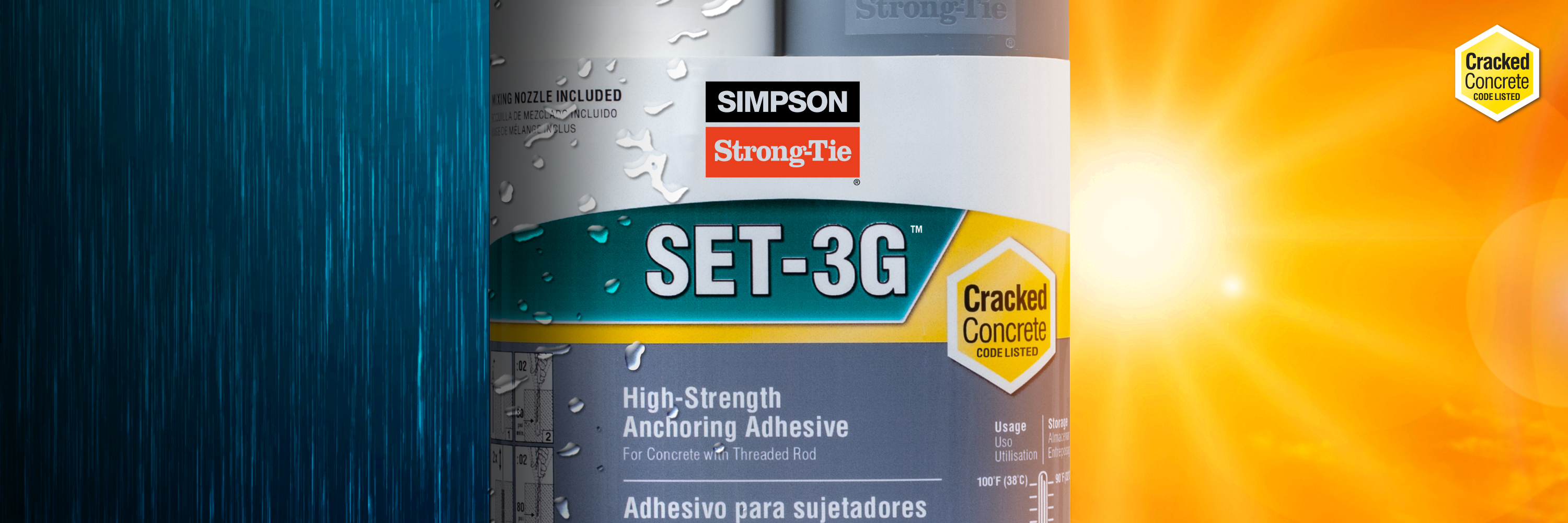Not all anchoring adhesives are created equal. There are important differences between acrylic-based and epoxy-based adhesive systems — differences that affect installation, gel and cure times, and anchoring performance. In the following post, Marlou Rodriguez, S.E., of Simpson Strong-Tie, lays out some of the comparative installation advantages of each system.
There are two common types of adhesives for anchoring threaded rod or rebar into concrete — epoxy-based systems and acrylic-based systems. What’s the difference? When should you specify one rather than the other? This blog post will help you understand the differences and guide you in choosing the best adhesive for your anchoring solution.

Simpson Strong-Tie offers a variety of code-listed adhesive products (see figure 1). Within the epoxy anchoring adhesive products category, we offer SET-3G™, SET-XP® and ET-HP® adhesive anchors. Within the acrylic anchoring adhesives product category, we offer AT-XP® adhesive. Both epoxy and acrylic adhesives come in a two- cartridge system consisting of a resin paired with a hardener (for epoxy) or an initiator (for acrylic). Releasing the adhesive with a dispensing tool allows the resin and the hardener or initiator to exit the cartridges into a mixing nozzle. When the resin mixes with the hardener or initiator, a chemical reaction occurs that allows the mixed adhesive to solidify.
Gel times and cure times are listed in the evaluation reports for adhesives. Gel time is the time needed for the adhesive to begin hardening. During the gel time, the user can install the threaded rod or reinforcing bar per the manufacturer’s printed installation instruction (MPII) in an adhesive-filled hole. The cure time listed is the time required for the adhesive to solidify sufficiently for structural loading. Moving or disturbing the anchor rod or reinforcing bar before adhesive is cured can adversely affect the performance of the anchor. There are distinct benefits associated with differing gel and cure times that Designers should consider when specifying an adhesive anchoring product.
Cure time is the most significant difference between the two types of adhesives. Some users assume that an epoxy adhesive is preferable only for warmer climates, whereas an acrylic is a cold-climate adhesive. Gel and cure temperatures for the adhesive types have different ranges, so the assumption that one should be used only in warmer climates and the other in colder climates is misleading. The more appropriate consideration is the time it takes each adhesive to cure once it’s mixed and the anchor is installed.
The time it takes the adhesive begin to harden, known as gel time, is very different between epoxy and acrylic adhesives. Tables 1 and 2 show the gel and cure times associated with Simpson Strong-Tie® SET-3G™ epoxy and AT-XP® acrylic adhesives.
| Concrete Temperature | Gel Time | Cure Time | |
| (°F) | (°C) | (min.) | (hr.) |
| 40 | 4 | 120 | 192 |
| 50 | 10 | 75 | 72 |
| 60 | 16 | 50 | 48 |
| 70 | 21 | 35 | 24 |
| 90 | 32 | 25 | 24 |
| 100 | 38 | 15 | 24 |
Table 1: SET-3G Gel and Cure Time Schedule.
| Concrete Temperature | Gel Time | Cure Time | |
| (°F) | (°C) | (min.) | (hr.) |
| 14 | –10 | 30 | 24 |
| 32 | 0 | 15 | 8 |
| 50 | 10 | 7 | 3 |
| 68 | 20 | 4 | 1 |
| 88 | 30 | 1.5 | 0.5 |
| 100 | 38 | 1 | 0.33 |
Table 2: AT-XP Gel and Cure Time Schedule.
If you compare their hardening times in 50°F concrete at time of installation, SET-3G will take 75 minutes to gel after mixing while AT-XP takes only seven minutes. The time it takes for the adhesive to cure is also very different — 72 hours for SET-3G in 50°F concrete versus only three hours for AT-XP.
There are advantages to each product when gel time is considered. When your adhesive anchoring solution requires deep embedment, you may want to consider an epoxy product, to allow sufficient time to dispense the product into the drilled hole and install the threaded rod or reinforcing bar. An acrylic product may gel too quickly for this type of application.
On the other hand, if you need to load an anchor within a few hours, you may wish to specify an acrylic product. Per Table 2 above, it takes an acrylic adhesive like AT-XP only three hours to cure fully, after mixing, when installed in 50°F concrete.
There are other differences between epoxy and acrylic adhesive beyond the gel and cure times. The following table provides a list of the differences.
| Epoxy | Acrylic |
| Long gel times | Short gel times |
| Long cure times | Short cure times |
| Long Shelf Life (2 years) | Shorter shelf life (1 Year) |
| High storage temperature | High-end storage temperature is capped at 80°F(product quality may be compromised when storage temperatures exceed 80°F |
| Good damp-hole performance | Reduced performance in damp holes |
| Higher bond strengths | Bond strengths are usually lower |
| Low temperature installations (14°F) | |
| Difficult to dispense at temperatures below 60°F | Good pump-ability at low temperatures |
| Low-temperature storage (14°F) | |
| Reduced performance at elevated temperatures | Very good elevated-temperature performance |
| Long nozzles required to achieve proper mixing | Shorter nozzles are compatible |
| Large-volume cartridges can be dispensed with manual dispensing tools |
|
| More of a gel consistency, making the use in horizontal and overhead applications easier |
|
| Adhesive does not shrink, allowing it to be used in oversized holes. | |
| Low temperature is restricted to 40°F | |
| Very stable chemistry |
Table 3: Epoxy vs. Acrylic Comparison Summary.
It’s important to understand the advantages and disadvantages of each type of adhesive for a given application. Epoxies and acrylics have distinct properties that will fit different applications and conditions. Simpson Strong-Tie® AT-XP® acrylic adhesive is available when you require a short cure time so you can load your anchor the same day you install it. Our SET-3G epoxy adhesive, now code listed by ICC-ES ESR-4057 (opens .pdf) for both cracked and uncracked concrete, will give you the highest bond strength in the market for common-size rods while allowing your installer the time they need to install their anchor per the MPII after properly injecting the adhesive in a predrilled hole.
Visit strongtie.com/set3g for more information on our new code-listed epoxy adhesive.





